 Roman coins of the emperors Carus, Carinus, and Numerian, 282-285. Their chronology.
Roman coins of the emperors Carus, Carinus, and Numerian, 282-285. Their chronology.
Carus became Roman emperor in 282 and soon promoted his sons Carinus and Numerian to the rank of Caesar and then, after a few months, to Augustus. Carus died, then Numerian died, and finally Carinus died.
Table 1: A table below lists these key events and explains what we see on the coins between successive events that helps us date the coins.
Table 2: A second table, far below, dates the coins given the titles on them. (This table may be all you want from this page.)
The coin above right. A 23 mm coin with Carus (balding), cuirassed right, with a radiate crown.
PAX EXERCITI (Peace of the Army), Pax standing holding a flower and a standard.
PXXI in exergue. P = Prima, for the first workshop (= officina) of the mint. XXI = the mark of the denomination, an aurelianus (a.k.a. antoninianus or, simply, "radiate"). XXI refers to the alloy introduced in the coin reform of Aurelian in 274, 20 parts copper and 1 part silver.
RIC 72, mint of Ticinum (now Pavia in northern Italy. References to RIC, Roman Imperial Coinage, are all to volume 5, part 2).
This coin does not have the type of reverse legend discussed below which enables closer dating than the obverse title "AVG". So this coin is dated from his accession in late August 282 until his death c. autumn 283.
What's new? 2025, July 11: Carinus as Caesar before Numerian became Caesar.
2025, Jan. 15: Carus, helmeted. Carus CONSECRATIO unlisted from Tripolis. Numerian as Augustus with AVGG. Numerian VNDIQVE VICTORES.
2024, Nov. 16: Numerian with two Gs from Antioch.
2024, May 29: Carus with two Gs, dated to autumn 282.
A short history. Carus was acclaimed Augustus by his troops in Germany, south of the Danube, at the end of August in 282. Probus, the emperor at the time, who was at Sirmium, was then killed by his own troops. Carus made his two sons Caesars, first the older, Carinus, and then a month later the younger, Numerian.
Carinus and Numerian
(Click the images to see the whole coin and its description)
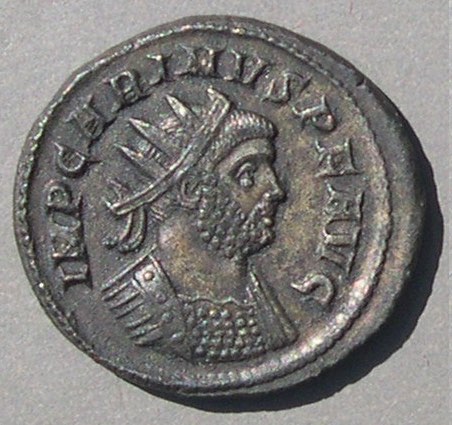 |
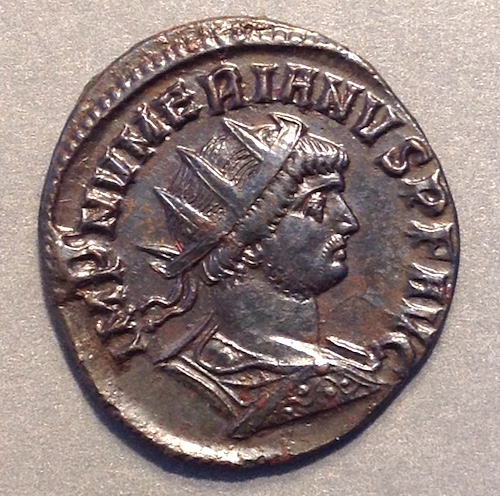 |
| Carinus as Augustus |
Numerian as Augustus |
After finishing action in the central empire, Carus went east accompanied by Numerian, with plans to regain Mesopotamia from the Sasanians, leaving Carinus behind to take care of the rest of the empire. At Antioch he promoted both sons to Augustus. He successfully captured the Sasanian capital, Ctesiphon, but was later found dead in his tent after a thunderstorm. The romantic story is he was struck by lightning, however subsequent events suggest he was murdered by the praetorian prefect Arrius Aper. Numerian inherited the war and made peace on favorable terms. However, while returning from Mesopotamia he, too, was found dead. This time Aper was accused of murder and was executed. On the spot Diocletian was chosen emperor by the army. That left Carinus still Augustus in the west. After dealing with the usurper Julian of Pannonia, Carinus went east to confront Diocletian.
The story is that Carinus was a womanizer and while Diocletian appeared to be losing a decisive battle with Carinus, Carinus was assassinated by an officer whose wife he had seduced. Diocletian inherited the empire. (The coins of Diocletian and his co-rulers are discussed on other pages.)
Coins of the family of Carus and their Chronology. The primary chronologial indication on a coin of Carnius or Numerian is on the obverse with the title Caesar, Augustus, or DIVO. Many reverse types give no further chronological information (e.g. the Carus at the top), but some do. The table here gives, in chronological order, the events that changed the rulers and the titles on the coins. Types with legend ending AVG, AVGG, or AVGGG indicate whether there is one ruler or more than one. The table shows when they were minted.
A different table, far below, gives the titles on coins and their dates. Use it for dating coins.
Carus, Carinus, and Numerian
Events in Chronological Order and the Coins that Follow Them
| Event |
Date |
Carus |
Carinus |
Numerian |
| 1) Carus becomes Augustus |
end of August 282 |
Obv: AVG
Rev: AVG (coin) |
-- |
-- |
| 2) Carinus made Caesar |
autumn 282 |
Obv: AVG
Rev: AVGG (coin) (coin) |
Obv: NOB CAES
Rev: AVGG (coin)
(coin from Antioch) |
-- |
| 3) Numerian made Caesar |
late autumn 282 |
Obv: AVG
Rev: AVGGG (only at Antioch) (coin)
or AVGG [continued from above except at Antioch] |
Obv: NOB C
Rev: AVGGG (only at Antioch)
or AVGG (coin)
|
Obv: NOB C
Rev: AVGGG (only at Antioch) (coin)
or AVGG (coin) |
4) Carinus and Numerian
promoted to Augustus |
February/March
283 |
continued
[not distinguishable from coins of the previous period] |
Obv: AVG
Rev: AVGGG (only at Antioch)
or AVGG [continued from above, but distinguishable by the obverse "AVG".] |
Obv: AVG
Rev: AVGGG (only at Antioch)
or AVGG [continued from above, but distinguishable by the obverse "AVG".] |
| 5) Carus dies |
c. autumn 283 |
DIVO (coin) |
Obv: AVG
Rev: AVGG (coin)
[not distinguishable from coins of the previous period, except at Antioch (no longer with 3 Gs)]
|
Obv: AVG
Rev: AVGG (coin)
[not distinguishable from coins of the previous period, except at Antioch (no longer with 3 Gs)]
|
6) Numerian dies
Carinus sole reign |
November 284 |
continued
[not distinguishable from coins of the previous period] |
Obv: AVG
Rev: AVG (coin)
[This is the only period in which Carinus properly has one G.] |
Obv: DIVO (coin)
Rev: CONSECRATIO |
| 7) Carinus dies |
Spring 285 |
Coins of Diocletian (on a different page) |
Key: Event numbers link to coins following those events.
"(coin)" links to an example below.
The reverse legends in this table include only reverse legends that end with AVG, AVGG, or AVGGG.
"--" means coins for that ruler were not issued in that time period.
"continued" means the previous legend (above) is continued and coins of the two time periods are not distinguished by that part of the legend.
On another page a table lists which kinds of legend-ending occur at each mint in RIC. (RIC was published in 1933 and is far from complete because much has been discovered since then.)
The table gives the "correct" usage of Gs, but there are some exceptions. I have seen a Carinus as Caesar with a one-G reverse (Jacquier 45, lot 1722) which does not fit any place in this scheme (That coin is probably a hybrid with an earlier reverse of Carus).
Note: "AVGG" does not necerarily mean two or more Augusti; It means two or more rulers, including Caesars. So, AVGGG was issued when Carus was Augustus and his sons were Caesars, and it was continued unchanged when his sons were promoted to Augusti.
Carus as sole Augustus (After Event 1, Carus becomes Augustus at end of August 282): Reverse legend with one G.
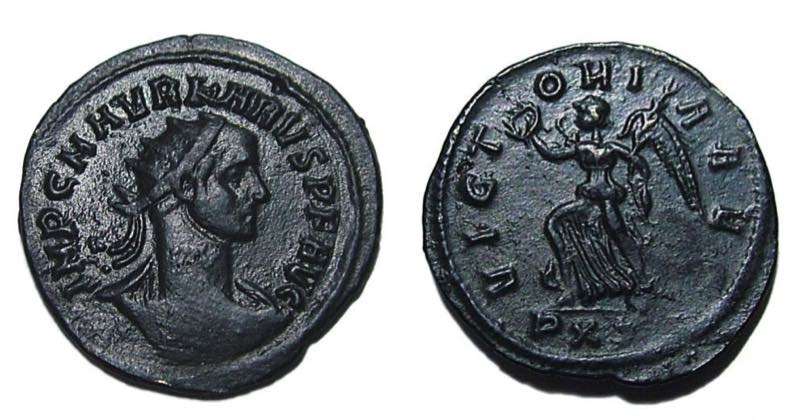 Carus
Carus
Struck sole reign, end of August 282 to autumn 282
22 mm. 2.17 grams.
IMP C M AVR KARVS PF AVG
"Karus" with a K instead of the C used later.
VICTORIA AVG
Victory walking left holding wreath and palm.
Coins of Carus with one G are scarce.
PXXI in exergue.
RIC 85. Ticinum mint.
Coins of Carus spelled with a "K" are early in his reign. Even if they don't have a reverse legend ending in "G" they are likely to be from this early period (next coin). There are some coins of Carinus spelled with a K, only at Ticinum.
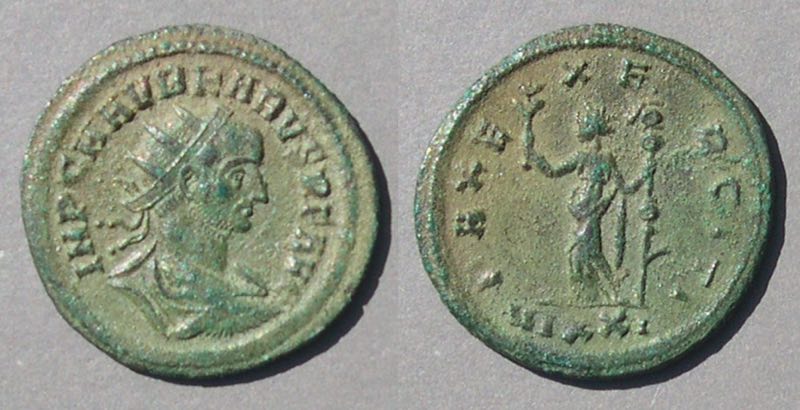 Carus
Carus
Probably struck sole reign, end of August 282 to autumn 282
23 mm. 3.86 grams.
IMP C M AVR KARVS PF AVG
PAX EXERCITI
Pax standing left holding flower and standard.
VIXXI
RIC 73, Ticinum mint.
There are coins of this period (with AVG on the reverse) with Carus spelled with a C, but none are illustrated here.
Carinus made Caesar by Carus (After Event 2, autumn 282): Carinus has obverse as Caesar.
 Carinus as Caesar
Carinus as Caesar
22 mm. 4.04 grams.
Struck as Caesar under Carus, autumn 282 to c. autumn 283.
M AVR CARINVS NOB CAES
CLEMENTIA • TEMP
Emperor holding short scepter receiving Victory on globe from Jupiter on right holding long scepter.
Є in middle field
XXI in exergue
RIC 202, Cyzicus mint.
It is not certain this coin is from before or after Numerian also became Caesar.
If the reverse legend of Carus terminates in AVGG it is after Carnius became Caesar.
 Carus
Carus
Struck after Carinus became Caesar, autumn 282.
22 mm. 4.03 grams.
IMP C M AVR CARVS PF AVG
VIRTVS AVGG•
Emperor holding short scepter receiving Victory on globe from Jupiter on right holding long scepter.
TR in middle field, for Tripolis
XXI below
RIC 128, Tripolis mint.
This coin is from the period after Event 2 when Carinus was made Caesar. When Numerian was elevated to Caesar, the reverse could have switched to three Gs, but there are no AVGGG coins from Tripolis, so we can't tell if this coin is from before or after Numerian became Caesar.
 Carus
Carus
Struck after Carinus became Caesar, autumn 282.
21 mm. 3.35 grams.
IMP C M AVR CARVS AVG
VICTORIA AVGG
Victory left on globe, captives either side
RIC V.II 18 variety (with AVGG), 22 variety (helmeted). Lugdunum
Sear III 12184v, page 495.
There are no AVGGG coins from Lugdunum, so we can't tell if this coin is from before or after Numerian became Caesar.
Numerian joins Carinus as Caesar under Carus (After Event 3, late autumn, 282): These could have three Gs, but Tripolis minted them with only two, as the next coin proves.
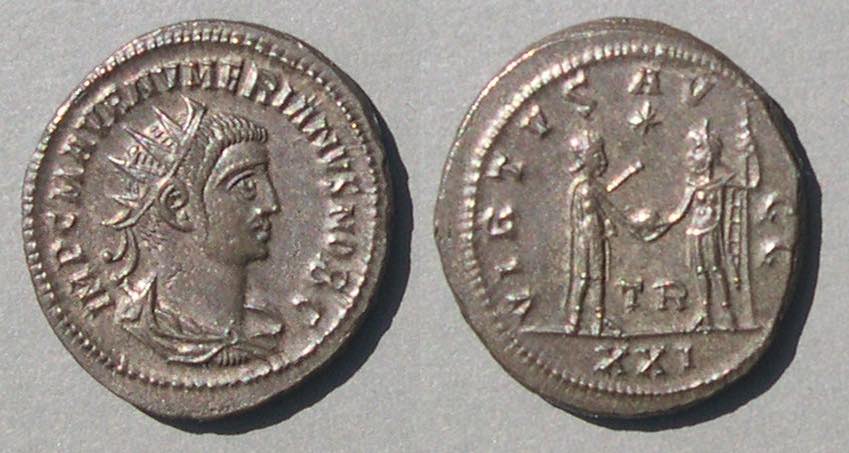 Numerian as Caesar
Numerian as Caesar
22mm. 4.85 grams.
IMP C M AVR NVMERIANVS NOB C
VIRTVS AVGG
Emperor holding short scepter receiving Victory on globe from Jupiter on right holding long scepter.
TR in field
XXI in exergue.
RIC 380, Tripolis mint.
When Numerian was Caesar there were three rulers and "AVGGG" would have been justified, but it was only used at Antioch.
Carinus was in the same issue at Tripolis. Whether his two-G coins at Tripolis are from before or after Numerian was made Caesar is not proven by the two Gs, as the previous coin shows.
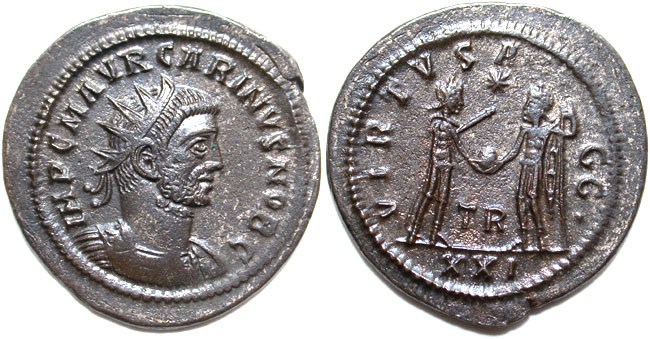 Carinus as Caesar
Carinus as Caesar
IMP C M AVR CARINVS NOB C
VIRTVS AVGG•
Emperor holding short scepter receiving Victory on globe from Jupiter on right holding long scepter.
TR in field
XXI in exergue.
RIC 209, Tripolis mint.
This coin has two Gs. It could be from before Numerian became Caesar and have two Gs, or from after Numerian became Caesar because only Antioch switched to three Gs for three rulers (next).
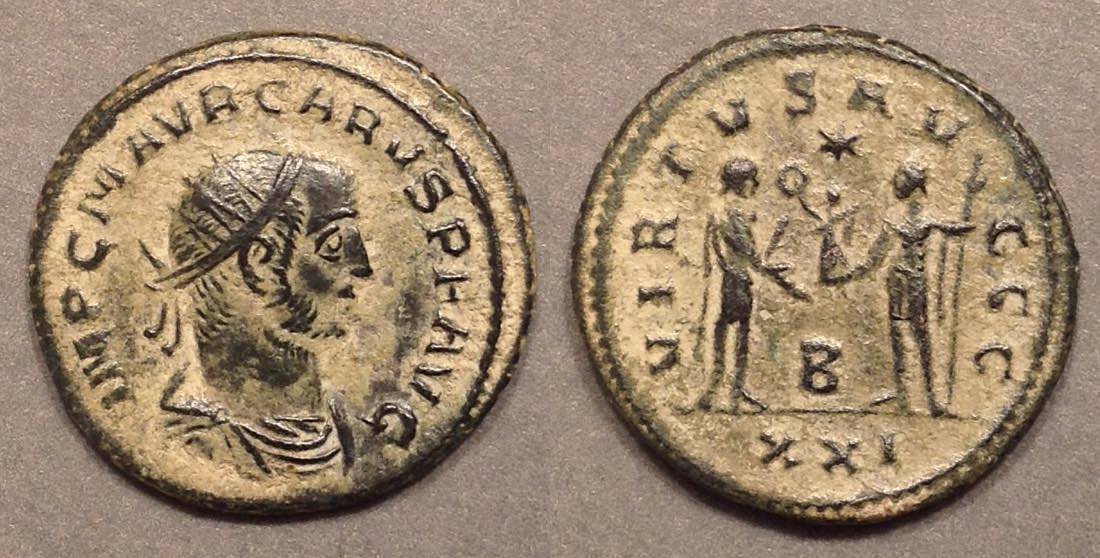 Carus, as Augustus
Carus, as Augustus
21-20 mm. 4.04 grams.
IMP C M AVR CARVS PF AVG
VIRTVS AVGGG (three Gs)
*
Δ
XXI
RIC V.II Carus 125, Antioch mint, page 150, Plate VI.17
Sear III 12190.
Coins of Carus with AVGGG attributed to this period might also belong to the next because they continue unchanged into the next period.
Many coins of Numerian as Caesar have two Gs, even though there were three rulers when he was Caesar. Only Antioch has three Gs for the three rulers: AVGGG.
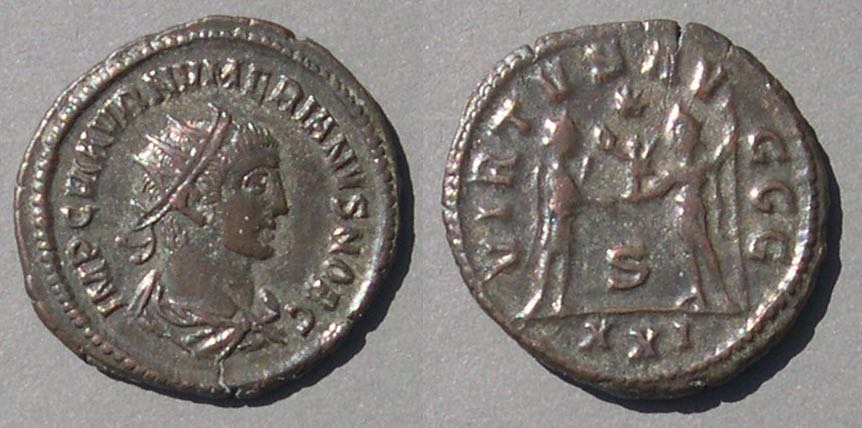 Numerian
Struck as Caesar, struck late August 282 to August 283
Numerian
Struck as Caesar, struck late August 282 to August 283
21 mm. 4.05 grams.
IMP C M AVR NVMERIANVS NOB C
VIRTVS AVGGG
Emperor holding short scepter receiving Victory on globe from Jupiter on right holding long scepter.
S
XXI
RIC 378, Antioch mint.
There are also coins with Carinus as Caesar with AVGGG (not illustrated here), all from this time period.
Antioch with two Gs. The previous coin shows that at Antioch three Gs were used when appropriate. That limits the time period when Antioch issued coins with two Gs.
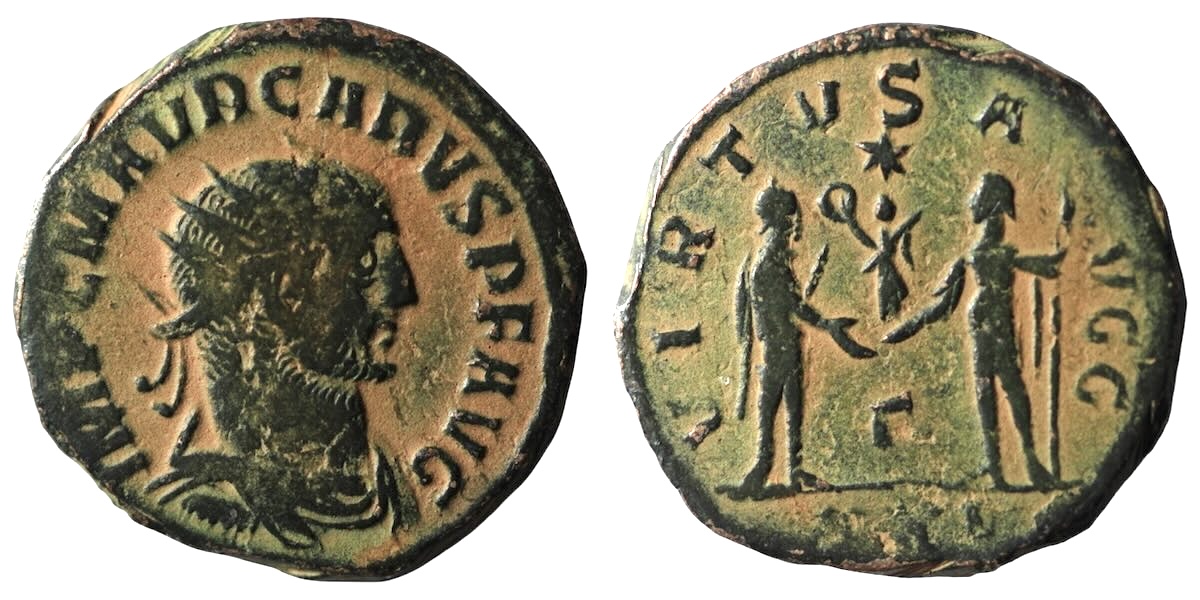 Carus, minted at Antioch, with two Gs.
Carus, minted at Antioch, with two Gs.
20-19 mm. 3.06 grams.
IMP C M AVR CARVS PF AVG
VIRTVS AVGG
Γ in field
XXI
RIC 124.
Two Gs should not be interpreted as meaning there were two Augusti, rather two rulers. In this case there was one Augustus (Carus) and one Caesar (Carinus). Because Antioch employed three Gs for three rulers, we can date this coin to autumn 282--the short time period after Carninus became Caesar in autumn 282 and before Numerian was made Caesar in late autumn 282 (We don't have precise dates for those events).
Because Antioch uses GGG when Numerian is Caesar (second coin above), we can assume that Carinus with GG must be before Numerian became Caesar.
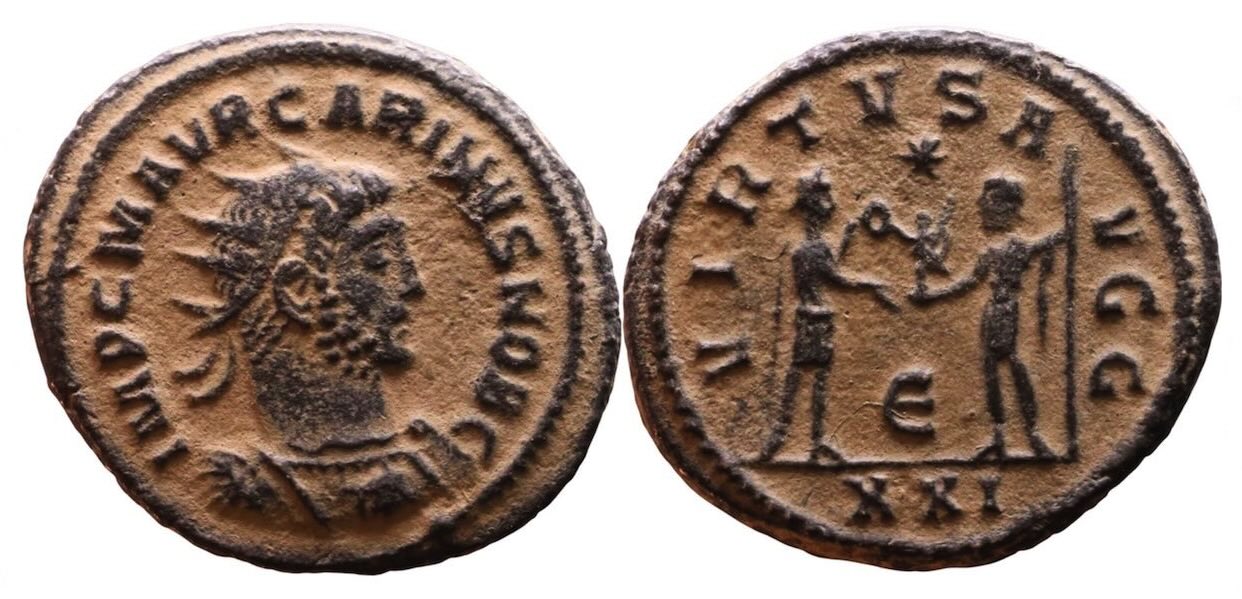 Carinus
Carinus
Struck as Caesar at Antioch, after he became Caesar and before Numerian became Caesar, that is, autumn 282 to late autumn 282, a rather narrow date range.
IMP C M AVR CARINVS NOB C
VIRTVS AVGG (with 2 Gs--it would have had 3 if Numerian were already Caesar)
*
Є
XXI
RIC 5.2 Carinus 208. Antioch.
Carinus and Numerian promoted to Augustus (After Event 4, February/March 283): Only Antioch labeled its coins using the rule that three rulers warrant three Gs: AVGGG. Antioch used AVGGG both before and after Carinus and Numerian were promoted to Augusti. Coins of Carus are unchanged, but the title of Carinus and Carus on the obverse changes from Caesar to Augustus.
[There are no coins of Carinus or Numerian as Augustus with AVGGG illustrated on this page. They are not rare and would be from Antioch.]
Coins of Carus and Carinus as Augustus at other mints have two Gs both before and after the death of Carus. Except for coins of Antioch we cannot usually tell if a coin of Carinus or Numerian as Augustus is before or after Carus died because two Gs are used in both time intervals.
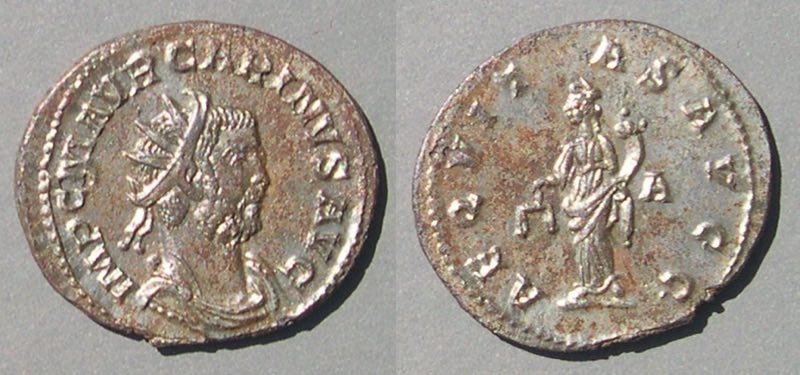 Carinus, as Augustus
Carinus, as Augustus
23-21 mm. 2.89 grams.
Struck with Numerian
(Whether this is from before or after Numerian became Augustus is uncertain, but it does have a long obverse legend which is typical of early issues.)
IMP C M AVR CARINVS AVG
AEQVITAS AVGG
A in right field
RIC 212, Lugdunum mint.
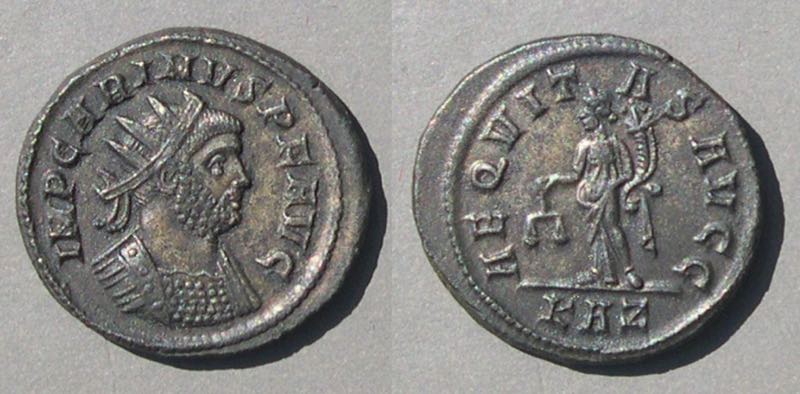 Carinus, as Augustus
Carinus, as Augustus
Struck August 283 to November 284.
23 mm. 4.70 grams.
IMP CARINVS PF AVG
AEQVITAS AVGG
KAZ
"KA" is the Greek equivalent of "XXI" and "Z" is for the seventh officina (workshop). It is odd that Rome would use Greek in its mintmarks, but it did. Diocletian changed back to using XXI.
It is uncertain if this was struck before or after Numerian became co-Augustus, however that promotion was soon after Carinus became Augustus and the time interval with Numerian as co-Augustus is longer, so this is likely with Numerian as Augustus. Also, the obverse legend is short, which usually belongs to later issues.
RIC 239, Rome mint.
 Carinus as Augustus
Carinus as Augustus
22 mm. 3.40 grams.
VIRTVS AVGG• with two Gs.
*
TR
Two Gs would be proper for Carinus as Augustus after the death of Carus, but Tripolis did not ever use three Gs, so it could be from before the death of Carus.
The Numerian coin as Caesar (above) from Tripolis proves than three Gs did not always appear when they could. So, this coin is after Carinus became Augustus and before Numerian died (after which the reverses of Carinus had only one G: AVG).
RIC 329, Tripolis mint.
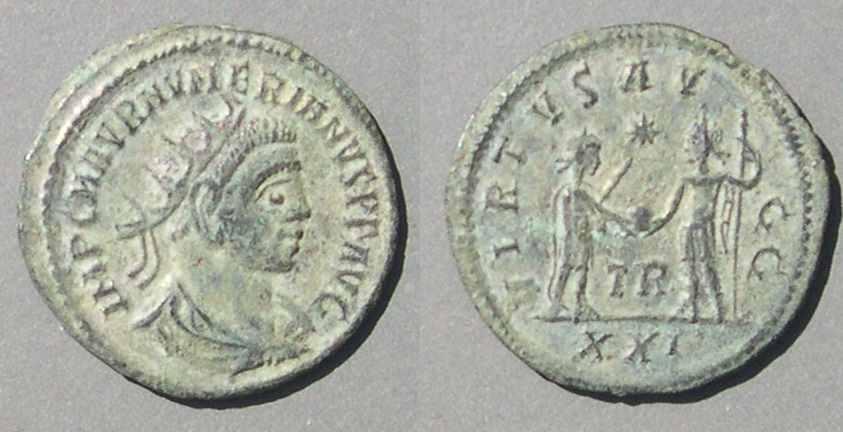 Numerian as Augustus
Numerian as Augustus
21 mm. 3.32 grams.
Struck Feb/Mar 283 - Autumn 284.
VIRTVS AVGG with two Gs.
*
TR
RIC 470, Tripolis mint.
Two Gs would be proper for Numerian as Augustus after the death of Carus, but Tripolis did not ever use three Gs, so it could be from before the death of Carus.
The Numerian coin as Caesar (above) from Tripolis proves than three Gs did not always appear when they could, because all three were alive when Numerian was Caesar.
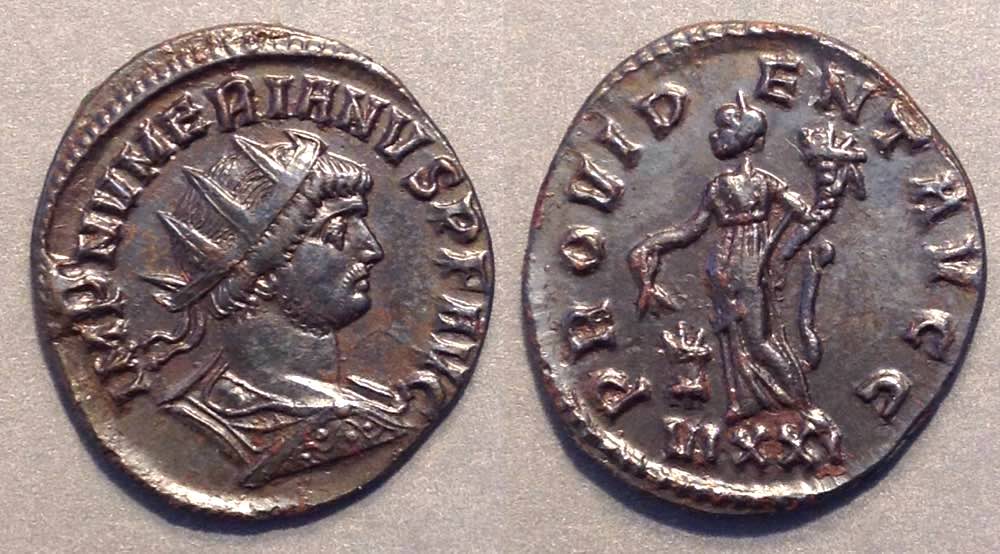 Numerian as Augustus
Numerian as Augustus
Struck autumn 283 to November 284
22-20 mm. 3.60 grams.
IMP NVMERIANVS PF AVG
PROVIDENT AVGG
Providentia standing left holding ears of grain and cornucopia, at foot a modius.
VIXXI in exergue.
RIC 447, Ticinum mint.
The mints other than Antioch used AVGG even if Carus was still alive and there were three rulers, so we can't tell if this coin was issued before or after Carus died.
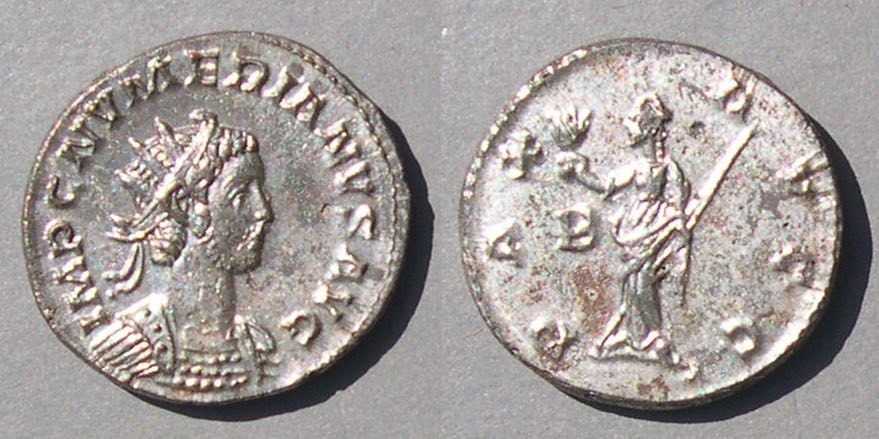 Numerian as Augustus
Numerian as Augustus
Struck autumn 283 to November 284
22 mm. 4.53 grams.
IMP C NVMERIANVS PF AVG
PAX AVGG
B in left field (second officina)
RIC 394, Lugdunum mint.
Carus dies and Carinus and Numerian remain co-Augusti (After Event 5, c. autumn 283).
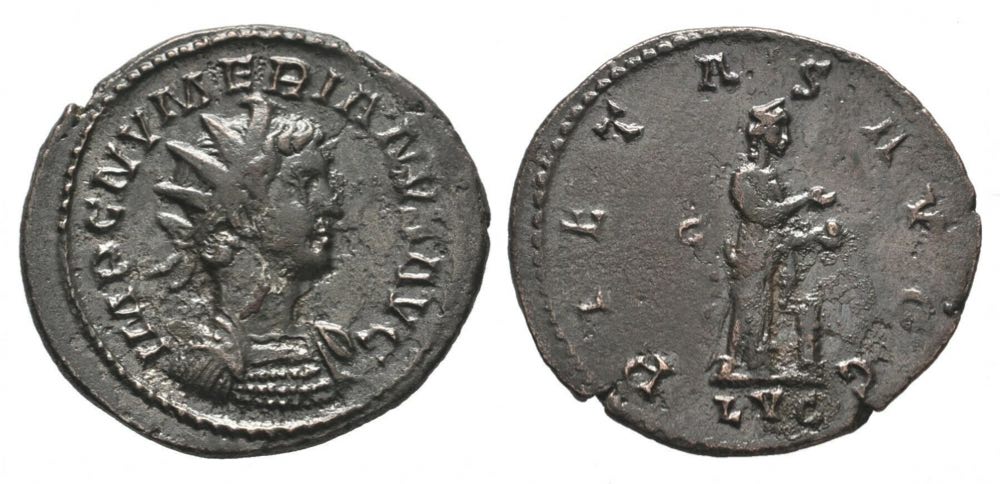 Numerian as Augustus
Numerian as Augustus
23-22 mm. 3.18 grams.
PIETAS AVGG
Pietas standing right holding globe over altar
C in left field.
LVG in exergue.
RIC 396, Lugdunum mint.
This and some types for Carinus as Augustus are the first imperial coins that have "LVG" for Lugdunum. The fact there are no "LVG" types for Carus is evidence these were struck after the death of Carus.
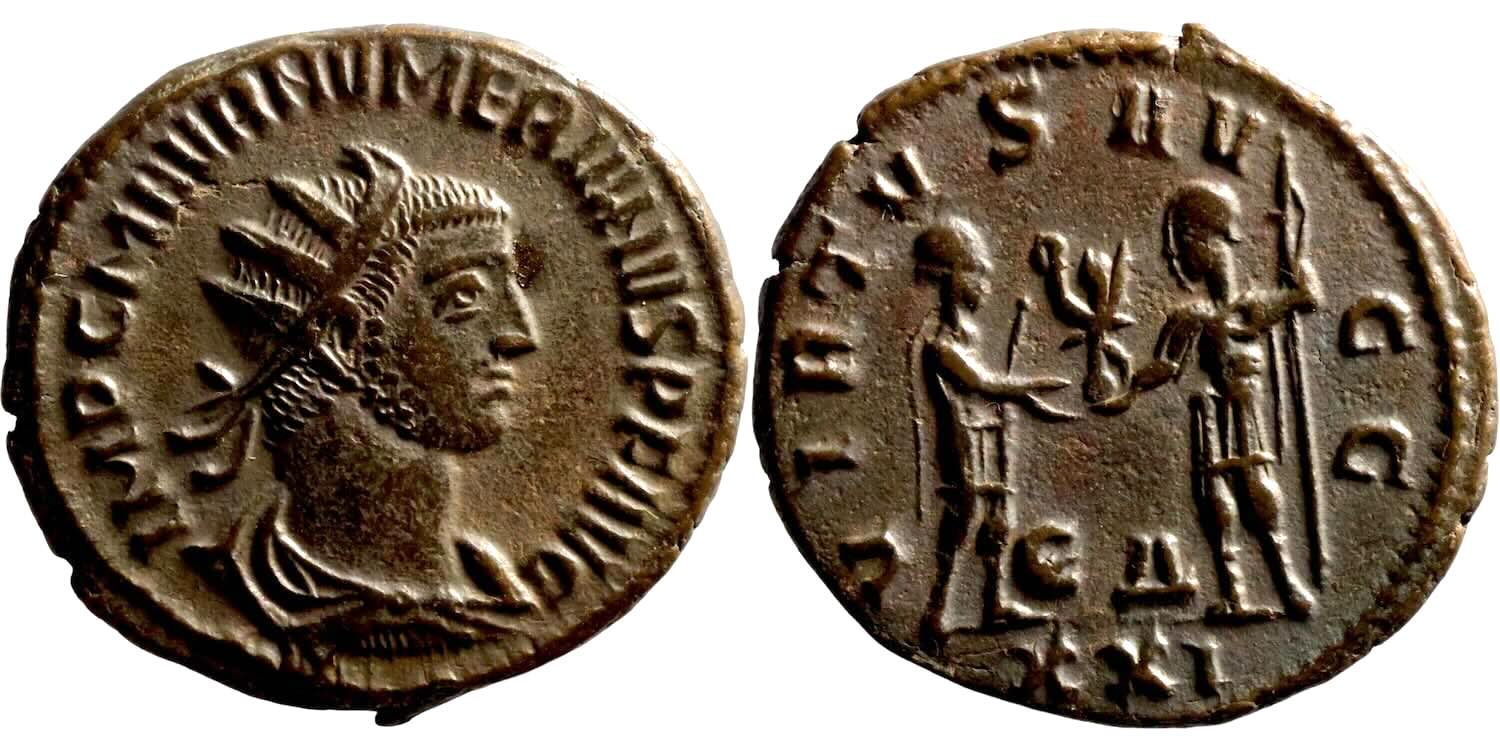 Numerian as Augustus
Numerian as Augustus
21-20 mm. 3.54 grams.
At Antioch,
VIRTVS AVGG
Carinus and Numerian with Victory on globe.
ЄΔ in filed (for "9") and XXI below.
Numerian was the thrid ruler in the family. At Antioch when all three were alive, reverses with Augustus has AVGGG with three Gs. This example, with only two Gs, must be after Carus died c. autum 283 and befoer Numerian died November 284..
DIVO CARO. It seems likely that DIVO pieces for Carus begin immediately after his death c. autumn 283 (Event 5). In addition to pieces with DIVO CARO AVG and DIVO CARO PIO, his Parthian war is commemorated with two new titles: PARTHICO and PERS.
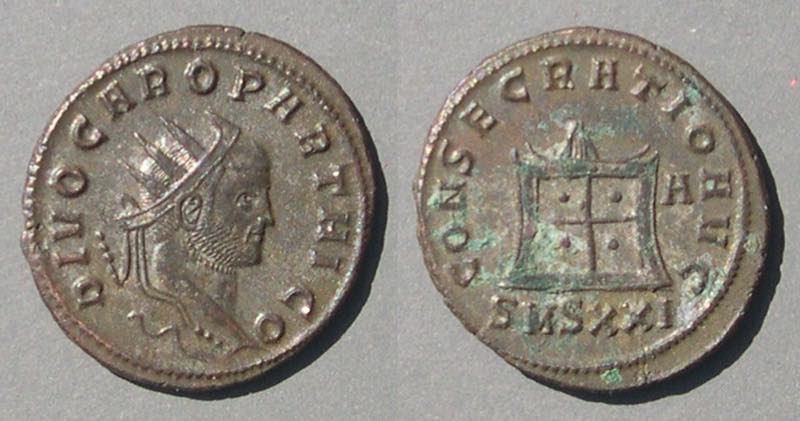 Carus
Carus
Struck posthumously, c. autumn 283 to spring 285.
22 mm. 3.84 grams.
Whether Numerian was Caesar, Augustus, or deceased is not certain. The reverse legend has "AVG" with only one G, but there is only one consecrated Augustus, so that indicator does not help.
DIVO CARO PARTHICO
CONSECRATIO AVG
altar, flaming, square. A in right field
SMSXXI = Sacra Moneta Siscia XXI
RIC 111, Siscia mint.
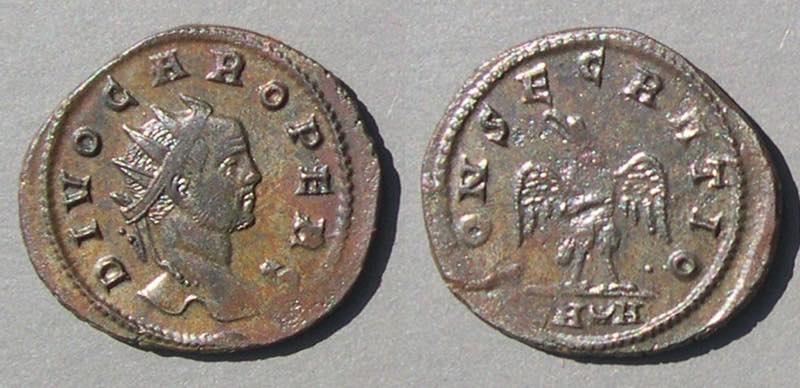 Carus
Carus
Struck posthumously, c. autumn 283 to spring 285.
22-21 mm. 4.34 grams.
DIVO CARO PERS
CONSECRATIO
eagle standing, wings half spread, held left
KA<crescent>A (On this coin the "K" in "KA" is flat. Again, at Rome, "KA" is the equivalent of "XXI")
RIC 48, Rome mint.
Note for collectors: The PARTHICO legend caries a premium over the usual AVG reverse and the PERS legend, much scarcer, carries a large premium.
 Carus
Struck posthumously, c. autumn 283 to spring 285.
Carus
Struck posthumously, c. autumn 283 to spring 285.
24-22 mm. 3.79 grams.
DIVO CARO AVG
CONSECRATIO
eagle standing left, wings half spread
T R
XXI
RIC 128, Tripolis mint.
 Carus
Struck posthumously, c. autumn 283 to spring 285.
Carus
Struck posthumously, c. autumn 283 to spring 285.
21 mm. 3.86 grams.
DIVO CARO AVG
CONSECRATIO
flaming altar
T R
XXI
Not in RIC with an altar. RIC 128 variety, Tripolis mint.
Posthumous coins for Carus were also struck in Egypt.
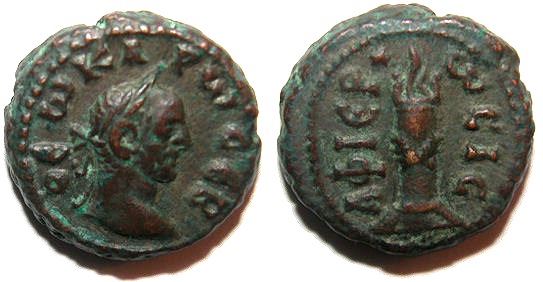 Carus
Carus
Struck posthumously at Alexandria, Egypt,
c. autumn 283 to spring 285.
19 mm. 8.44 grams.
ΘЄω KAPω CЄB
AΦIЄP* ωCIC [= CONSECRATIO]
Flaming altar
Sear III 12406
Emmett 3995.
Carinus and Numerian strike in Egypt for Legion II, Traiana.
Carnius and Carus were the only rulers to strike Egyptian tetradrachms with reference to a particular legion. It was Legion II, Traiana. Why that legion and why at this time is not known. Since Carus is not included, the issue is from after Carus died.
 Carinus
Carinus
19 mm. 7.78 grams.
AK MA KAPINOC CEB
ΛEG B TRAI
eagle standing left, head back with wreath in beak
LΓ, year 3, his last year.
Emmett 4004. Sear III 12386.
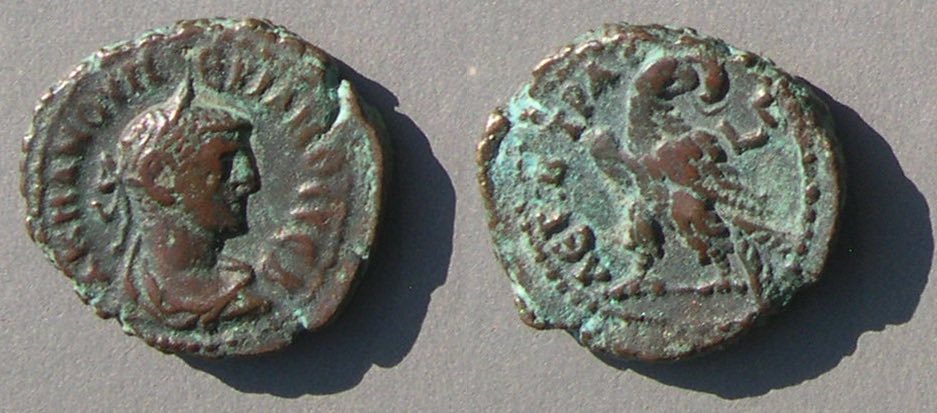 Numerian
Numerian
21-19 mm.
AK MA NOVMEPIANOC CEB
ΛEG B TRAI
eagle standing left, head back with wreath in beak
LΓ, year 3, his last year.
Emmett 4017. Sear III 12279
Carinus as Augustus, sole reign, after the death of Numerian in November 284 (After Event 6). The "AVG" coins attributed to the sole rule Carinus are distinguished by "AVG" (with only one G) on both sides. The coins of Numerian are DIVO pieces which are only from the sole reign of Carinus.
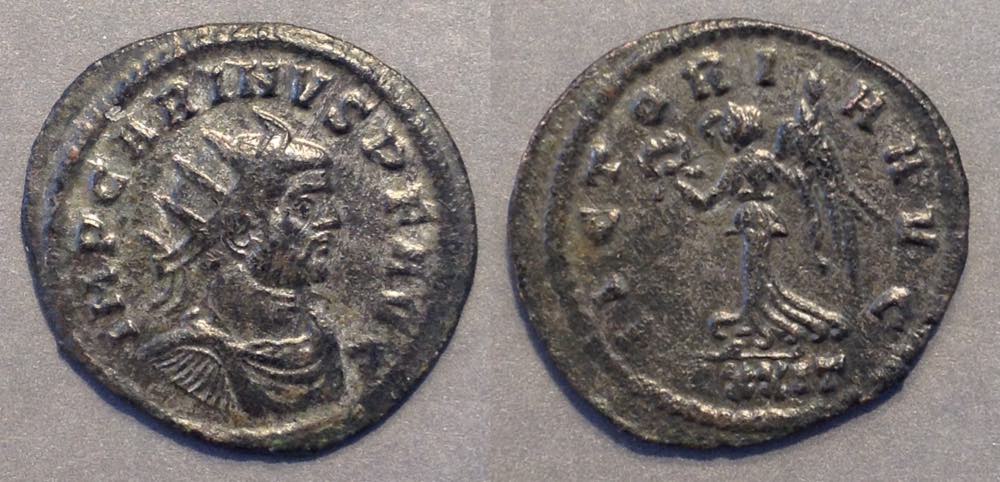 Carnius, as Augustus
Carnius, as Augustus
Struck Nov. 284 - spring 285.
24-23 mm. 2.91 grams,
IMP CARINVS PF AVG
VICTORIA AVG
Victory advancing left
QXXIT in exergue
RIC 304. Ticinum mint.
 Numerian, after his death
Numerian, after his death
21 mm. 3.17 grams.
Struck Nov. 284 - spring 285.
This is easy to date because it is after the death of Numerian (which was after the death of Carus) and before the dynasty of Carus ended with the death of Carinus.
DIVO NVMERIAN
CONSECRATIO
Eagle standing with wings half spread and head left
KAA
RIC Numerianus Augustus 424, Rome mint, page 196
If a reverse legend does not terminate with AVG, AVGG, or AVGGG (e.g. PAX EXERCITI for Carus), the only chronological information we have is the obverse title Augustus, Caesar, or DIVO.
 Carinus, as Caesar
Carinus, as Caesar
Struck as Caesar, Autumn 282 - Feb/Mar 283.
22 mm. 4.04 grams.
M AVR CARINVS NOB CAES
CLEMENTIA • TEMP
Є
XXI
RIC Cyzicus 202v.
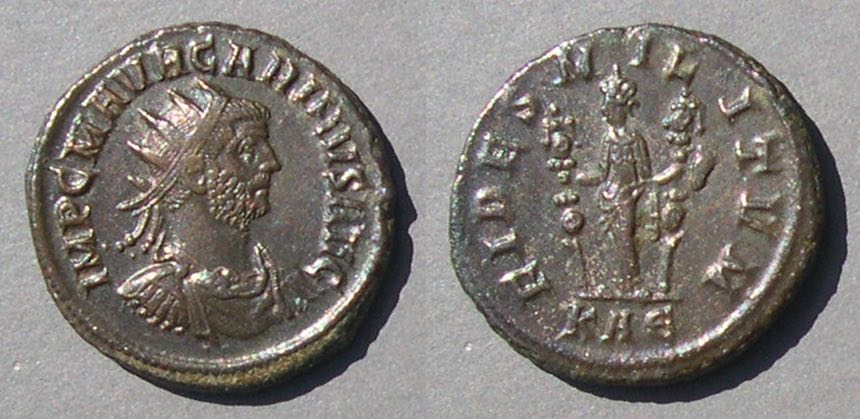 Carinus, as Augustus
Carinus, as Augustus
Struck Feb/March 283 - Spring 285.
21 mm. 4.58 grams.
IMP C M AVR CARINVS AVG
FIDES MILITVM
KAЄ
RIC 170, Rome mint.
The date is limited only by his title of Augustus. Whether Carus and Numerian were still alive as co-rulers cannot be determined by the reverse legend.
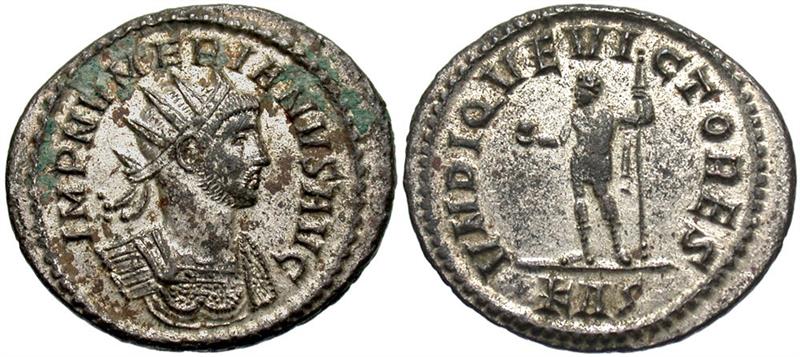 Numerian, as Augustus
Numerian, as Augustus
Struck Feb/Mar 283 - Autumn 284
22-20 mm. 3.72 grams.
IMP NVMERIANVS AVG
VNDIQVE VICTORES
KAS
RIC 423, Rome.
The date is limited only by his title of Augustus.
Other people on Roman coins. The two other people on coins of this period are a wife of Carinus, Magnia Urbica, and a usurper, Julian of Pannonia, defeated by Carinus.
Magnia Urbica, wife of Carinus.
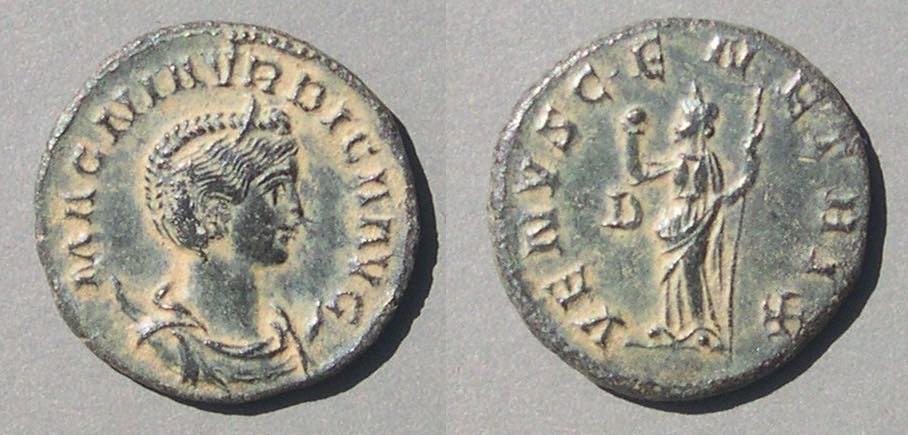 Magnia Urbica
Magnia Urbica
wife of Carinus
21 mm. 4.02 grams.
Stuck late in the reign at Lugdunum
MAGNIA VRBICA AVG
VENVS GENETRIX
D in left field
RIC 337, Lugdunum mint, "R."
Note for collectors: Before the 1990s Magnia Urbica was quite rare, but many have appeared since then. She is still rare, but not as rare as she used to be.
Julian of Pannonia (Nov 284 to Feb. 285) revolted against Carinus and took control of the prolific Siscia mint in Pannonia.
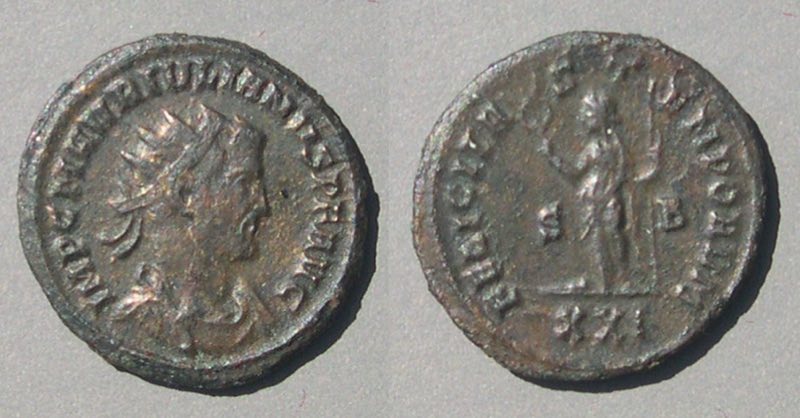 Julian of Pannonia
Julian of Pannonia
22 mm. 4.21 grams.
IMP C M AVR IVLIANVS PF AVG
FELICITAS TEMPORVM
S B in fields
XXI
RIC 2, Siscia mint, "R3".
Note for collectors: Julian was extremely rare before the 1990s and now, like Magnia Urbia, is less rare than he used to be, although he remains very expensive.
There are also very rare coins of DIVO NIGRINIANO, apparently a deceased son of Numerian.
Titles to dates: This table has the information in the first table organized by emperor in order to date coins.
| Ruler |
obverse
title |
reverse
title |
Dates |
| Carus |
AVG |
AVG
AVGG
AVGGG |
August 282-autumn 282
August 282-autumn 283
late autumn 282-autumn 283 |
| Carus |
DIVO |
CONSECRATIO |
autumn 283-spring 285 |
| Carinus |
NOB C |
AVG --
AVGG
AVGG at Antioch
AVGGG |
--
autumn 282-Feb/Mar 283
autumn 282-late autumn 282
late autumn 282-Feb/Mar 283 |
| Carinus |
AVG |
AVG
AVGG
AVGGG |
Nov 284-spring 285
Feb/Mar 283-Nov 284
Feb/Mar 283-Nov 284 |
| Numerian |
NOB C |
AVG --
AVGG
AVGGG |
--
late autumn 282-Feb/Mar 283
late autumn 282-Feb/Mar 283 |
| Numerian |
AVG |
AVG --
AVGG
AVGGG
|
--
Feb/Mar 283-Nov 284
Feb/Mar 283-Nov 284 |
| Numerian |
DIVO |
CONSECRATIO |
Nov. 284 - spring 285 |
Of course, as before, this table assumes that the coins use titles properly. Usually they do, but there are rare exceptions.
For another website on coins of Carus and his family, see: http://othila-coins.com/
Fakes. Here is a deceptive fake quinarius of Carinus, obtained from eBay.
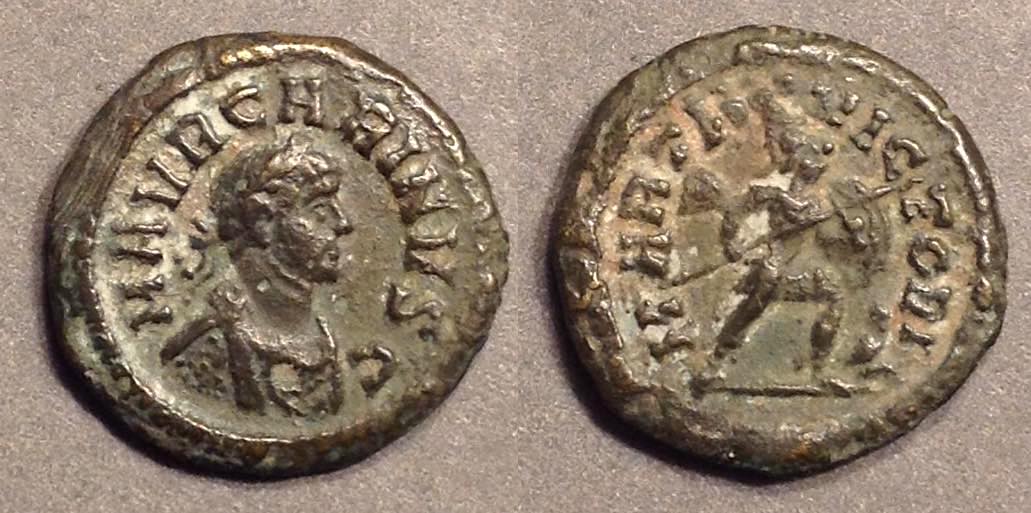 Carinus, 283-285
Carinus, 283-285
15 mm. 1.72 grams.
MARTI VICTORI
There are several identical examples to be found on the web. Distinctive are the circular pit in the cuirass, the pit on the neck, and a pit below the chin, as well as the rim scrape at 10:00-11:30 on the reverse and the odd extra metal at the back of the helmet on Mars. The coin must be cast, but shows little signs of casting. The rim at 10:00 shows signs of filing, which may be where a sprue was removed. Of course, it is possible that one of the identical coins on the web is an original from which the others are cast, but I doubt it. I think all the coins with these flaws are modern fakes.
Go to the Table of Contents of this entire educational site.
Go to pages on the coins of Diocletian and later rulers, 284-324.
 Roman coins of the emperors Carus, Carinus, and Numerian, 282-285. Their chronology.
Roman coins of the emperors Carus, Carinus, and Numerian, 282-285. Their chronology. 

 Carus
Carus Carus
Carus Carinus as Caesar
Carinus as Caesar Carus
Carus Carus
Carus Numerian as Caesar
Numerian as Caesar Carinus as Caesar
Carinus as Caesar Carus, as Augustus
Carus, as Augustus Numerian
Numerian Carus, minted at Antioch, with two Gs.
Carus, minted at Antioch, with two Gs.
 Carinus, as Augustus
Carinus, as Augustus Carinus, as Augustus
Carinus, as Augustus Carinus as Augustus
Carinus as Augustus Numerian as Augustus
Numerian as Augustus Numerian as Augustus
Numerian as Augustus Numerian as Augustus
Numerian as Augustus Numerian as Augustus
Numerian as Augustus Numerian as Augustus
Numerian as Augustus Carus
Carus Carus
Carus Carus
Carus Carus
Carus Carus
Carus

 Carnius, as Augustus
Carnius, as Augustus Numerian, after his death
Numerian, after his death Carinus, as Augustus
Carinus, as Augustus Numerian, as Augustus
Numerian, as Augustus Magnia Urbica
Magnia Urbica Julian of Pannonia
Julian of Pannonia Carinus, 283-285
Carinus, 283-285